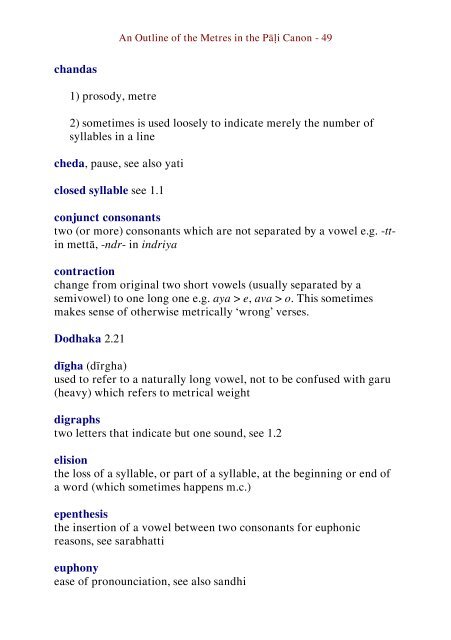An Outline of the Metres in the Pāḷi Canon
A concise but thorough explanation of the metres that are found in the Pāli canon, along with examples and glossary.
A concise but thorough explanation of the metres that are found in the Pāli canon, along with examples and glossary.
You also want an ePaper? Increase the reach of your titles
YUMPU automatically turns print PDFs into web optimized ePapers that Google loves.
<strong>An</strong> <strong>Outl<strong>in</strong>e</strong> <strong>of</strong> <strong>the</strong> <strong>Metres</strong> <strong>in</strong> <strong>the</strong> <strong>Pāḷi</strong> <strong>Canon</strong> - 49<br />
chandas<br />
1) prosody, metre<br />
2) sometimes is used loosely to <strong>in</strong>dicate merely <strong>the</strong> number <strong>of</strong><br />
syllables <strong>in</strong> a l<strong>in</strong>e<br />
cheda, pause, see also yati<br />
closed syllable see 1.1<br />
conjunct consonants<br />
two (or more) consonants which are not separated by a vowel e.g. -tt<strong>in</strong><br />
mettā, -ndr- <strong>in</strong> <strong>in</strong>driya<br />
contraction<br />
change from orig<strong>in</strong>al two short vowels (usually separated by a<br />
semivowel) to one long one e.g. aya > e, ava > o. This sometimes<br />
makes sense <strong>of</strong> o<strong>the</strong>rwise metrically ‘wrong’ verses.<br />
Dodhaka 2.21<br />
dīgha (dīrgha)<br />
used to refer to a naturally long vowel, not to be confused with garu<br />
(heavy) which refers to metrical weight<br />
digraphs<br />
two letters that <strong>in</strong>dicate but one sound, see 1.2<br />
elision<br />
<strong>the</strong> loss <strong>of</strong> a syllable, or part <strong>of</strong> a syllable, at <strong>the</strong> beg<strong>in</strong>n<strong>in</strong>g or end <strong>of</strong><br />
a word (which sometimes happens m.c.)<br />
epen<strong>the</strong>sis<br />
<strong>the</strong> <strong>in</strong>sertion <strong>of</strong> a vowel between two consonants for euphonic<br />
reasons, see sarabhatti<br />
euphony<br />
ease <strong>of</strong> pronounciation, see also sandhi

















